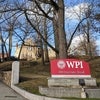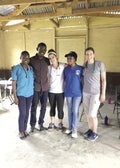A new weapon to fight the deadliest cancer
 Edd Cote
A low-dose CT scan can detect lung cancer at earlier stages, which gives doctors and patients a better chance of beating the disease.
Edd Cote
A low-dose CT scan can detect lung cancer at earlier stages, which gives doctors and patients a better chance of beating the disease.
Last spring Bob Checkosky, a 72-year-old retired chemist in Southbridge, read in the newspaper about a new screening for lung cancer. Then, he saw a billboard put up by Harrington Hospital advertising the same thing. He’d already tried to quit his lifelong smoking habit a few years back, and he was trying again. Even though he wasn’t all that worried about lung cancer, it seemed like a good idea to get checked out.
“I thought ‘Well, I’ve smoked all my life, and at my age it certainly can’t hurt to do it,’” Checkosky said.
He went into the hospital for the scan and got the results the next day. The doctors found something.
“They were very optimistic because it was really caught early, before I had any symptoms,” he said.
The medical personnel ordered more tests and put him into chemotherapy and radiation therapy.
“By November, when I finished up and did more scans, there was no sign of the cancer at all,” Checkosky said.
Lung cancer has long been a particularly terrifying diagnosis. Out of every 100 people who were found to have the disease between 2005 and 2011, only 17 percent were alive five years later, according to the National Cancer Institute’s Surveillance, Epidemiology, and End Results Program (SEER).
It’s the second most common cancer in the U.S., with 221,200 estimated new cases in 2015 – compared with 231,840 for breast cancer – but it’s by far the biggest killer. About 158,040 people died from the disease last year, more than three times as many as for the second deadliest type: colon and rectum cancer.
Those numbers could change, thanks to the new screening that Checkosky received at Harrington.
“Up until now, most [lung] cancers were found at a later stage, where the statistics were really against you,” said Dr. Max Rosen, chairman of the Radiology Department at UMass Medical School and UMass Memorial Medical Center. “To show somebody that ‘You have a small nodule, it needs to be biopsied, could be curative,’ it’s a very different conversation.”
The new weapon
In results published in 2012, the National Lung Cancer Screening Trial found that a low-dose CT scan could find cancer in the lungs of people who had smoked for many years when it was at an early, potentially treatable stage. In fact, Rosen said, the researchers stopped the study early after results showed a 20 percent reduction in the lung cancer death rate for people who got the scan. Some private insurers quickly began covering the scan, and in February 2015, Medicare and Medicaid followed suit.
The screening is now generally covered for anyone between ages 55 and 77 who either still smokes or quit within the past 15 years, and who smoked for a total of at least 30 “pack-years” – for example, a pack a day for 30 years, or two packs a day for 15 years. People who get the scan should go through smoking cessation counseling if they still smoke and be prepared to go through surgery or other treatment if it turns out to be necessary.
Even for smokers who aren’t found to have a growth that looks like cancer, the process can be eye-opening, Rosen said. He has gone through the CT scans with patients, showing them areas of emphysema or nodules that he wants to keep an eye on.
“It’s very powerful for people to see their lungs and see the effects of smoking,” he said.
Building awareness
Lisa Johnson, an interventional radiology nurse who is the clinical lead for the screening program at Harrington, said she’s seen growth in the number of patients coming in for the screening over the past year. The hospital began a marketing campaign for scans in early 2015, putting up billboards like the one Checkosky saw, leaving flyers in doctors’ waiting rooms and reaching out to physicians.
“We put it to physicians, stressed how important it is,” Johnson said. “This is just like breast cancer is for women over 40.”
Over the course of 2015, she said, the program screened more than 300 people. Twelve of them qualified for surgery, and others were flagged for additional tests or annual screenings.
MetroWest Medical Center started its own lung cancer CT screening program this January. The most intensive part of building the program was ensuring that patients could get the support and counseling they needed, said Dr. Amogh Srivastava, a diagnostic radiology specialist at the hospital.
Best preventative: No smoking
The scans themselves are a relatively simple process from the patients’ perspective, Srivastava said, but it’s crucial to use the opportunity to help smokers quit.
“Screening is not a substitute for stopping smoking,” he said. “If you want to not have lung cancer, the most important thing you can do is not smoke.”
The rate of smoking by U.S. adults dropped from 42 percent in 1965 to 15 percent in 2015, according to the Centers for Disease Control and Prevention. Former longtime smokers are aging into the 55-plus demographic at highest risk, and Srivastava said even 15 percent of Americans is a lot.
“There’s still a very large number of people who smoke,” he said.
For members of that population, like Bob Checkosky, even long years of smoking no longer add up to a game of Russian roulette that they’re powerless to even try to stop. Since November, Checkosky has been cancer-free, though he’s gone back to Harrington for a new round of radiation to protect against cancer reemerging in his brain.
“Those people are terrific over there,” Checkosky said. “I couldn’t be happier with the treatment… Based on my experience, I would recommend [the screening] to anybody that was a lifelong smoker.”













0 Comments